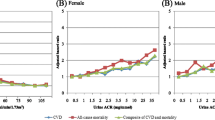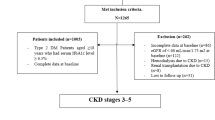Abstract
Purpose
To evaluate the prevalence of diabetic nephropathy and different categories of estimated glomerular filtration rate (eGFR) as calculated by the CKD-EPI equation among Chinese patients with type 2 diabetes in primary care in Hong Kong. The associated factors of diabetic nephropathy were also analyzed.
Methods
A cross-sectional study was conducted in 35,109 Chinese patients with type 2 diabetes followed up in all General Outpatient Clinics in a Hospital Authority cluster and had undergone comprehensive diabetic complication assessment from April 2013 to March 2016. The GFR was estimated by the CKD-EPI equation. Logistic regression was used to analyze the associated factors of diabetic nephropathy.
Results
The prevalence of diabetic nephropathy (with either or both albuminuria and impaired eGFR), impaired eGFR (with or without albuminuria) and albuminuria (with or without impaired eGFR) was 31.6%, 16.9% and 22.0% respectively. The prevalence of eGFR categories 1, 2, 3, 4 and 5 was 36.0%, 47.1%, 15.7%, 1.1% and 0.1% respectively. The comorbidity with hypertension or presence of other diabetic microvascular or macrovascular complications including diabetic retinopathy, peripheral neuropathy, peripheral vascular disease, history of stroke and history of ischemic heart disease had strong association with diabetic nephropathy. Obesity, smoking, suboptimal control of blood pressure, hemoglobin A1c and non-high density lipoprotein cholesterol were also significantly associated with diabetic nephropathy.
Conclusions
Diabetic nephropathy was common among Chinese patients with type 2 diabetes in primary care in Hong Kong. Early identification and control of the modifiable risk factors are of upmost importance in preventing the complication.

Similar content being viewed by others
References
World Health Organization. Global status report on noncommunicable diseases 2014 [article online]. 2014. Available from: http://www.who.int/nmh/publications/ncd-status-report-2014/en/. Accessed 13 Mar 2016.
Whiting D, Guariguata L, Weil C, et al. IDF diabetes atlas: global estimates of the prevalence of diabetes for 2011 and 2030. Diabetes Res Clin Pract. 2011;94(3):311–21.
Wong K, Wang Z. Prevalence of type 2 diabetes mellitus of Chinese populations in mainland China, Hong Kong, and Taiwan. Diabetes Res Clin Pract. 2006;73(2):126–34.
Jha V, Garcia-Garcia G, Iseki K, et al. Chronic kidney disease: global dimension and perspectives. Lancet. 2013;382 North American Edition (9888):260–72.
Saunders WB. KDOQI clinical practice guidelines and clinical practice recommendations for diabetes and chronic kidney disease. Am J Kidney Dis. 2007;49(2 Suppl 2):S12–154.
de Boer I, Rue T, Hall Y, Heagerty PJ, Weiss NS, Himmelfarb J. Temporal trends in the prevalence of diabetic kidney disease in the United States. JAMA. 2011;305(24):2532–9.
Lou Q-L, Ouyang X-J, Liu-Bao G, et al. Chronic kidney disease and associated cardiovascular risk factors in Chinese with type 2 diabetes. Diabetes Metab J. 2012;36(6):433–42.
Ho Y, Chau K, Choy B, et al. Hong Kong renal registry report 2012. Hong Kong J Nephrol. 2013;15(1):28–43.
Matsushita K, van der Velde M, Astor B, et al. Association of estimated glomerular filtration rate and albuminuria with all-cause and cardiovascular mortality in general population cohorts: a collaborative meta-analysis. Lancet. 2010;375 North American Edition (9731):2073–81.
Gansevoort R, Matsushita K, van der Velde M, Astor BC, Woodward M, Levey AS, et al. Lower estimated GFR and higher albuminuria are associated with adverse kidney outcomes. A collaborative meta-analysis of general and high-risk population cohorts. Kidney Int. 2011;80(1):93–104.
Goede P, Lund-Andersen H, Parving H, et al. Effect of a multifactorial intervention on mortality in type 2 diabetes. N Engl J Med. 2008;358(6):580–91.
Zoungas S, de Galan B, Ninomiya T, et al. Combined effects of routine blood pressure lowering and intensive glucose control on macrovascular and microvascular outcomes in patients with type 2 diabetes: new results from the ADVANCE trial. Diabetes Care. 2009;32(11):2068–74.
Bilous R. Microvascular disease: what does the UKPDS tell us about diabetic nephropathy? Diabet Med. 2008;Suppl 2:25–9.
Johnson C, Levey A, Coresh J, Levin A, Lau J, Eknoyan G. Clinical practice guidelines for chronic kidney disease in adults: part I. definition, disease stages, evaluation, treatment, and risk factors. Am Fam Physician. 2004;70(5):869–985.
Levey A, Bosch J, Lewis J, Greene T, Rogers N, Roth D. A more accurate method to estimate glomerular filtration rate from serum creatinine: a new prediction equation. Modification of diet in renal disease study group. Ann Intern Med. 1999;130(6):461–70.
Stevens L, Coresh J, Feldman H, et al. Evaluation of the modification of diet in renal disease study equation in a large diverse population. J Am Soc Nephrol. 2007;18(10):2749–57.
National Kidney Foundation. Frequently asked questions about GFR estimates [article online]. 2014. Available from: https://www.kidney.org/sites/default/files/12-10-4004_FAQ-ABE.pdf. Accessed 23 Nov 2018.
Levey A, Stevens L, Schmid C, et al. A new equation to estimate glomerular filtration rate. Ann Intern Med. 2009;150(9):604–12.
Inker L, Shaffi K, Levey A. Estimating glomerular filtration rate using the chronic kidney disease-epidemiology collaboration creatinine equation: better risk predictions. Circ Heart Fail. 2012;5(3):303–6.
Kilbride H, Stevens P, Eaglestone G, et al. Accuracy of the MDRD (modification of diet in renal disease) study and CKD-EPI (CKD epidemiology collaboration) equations for estimation of GFR in the elderly. Am J Kidney Dis. 2013;61(1):57–66.
Liao Y, Liao W, Liu J, Xu G, Zeng R. Assessment of the CKD-EPI equation to estimate glomerular filtration rate in adults from a Chinese CKD population. J Int Med Res. 2011;39(6):2273–80.
Matsushita K, Selvin E, Bash L, et al. Risk implications of the new CKD epidemiology collaboration (CKD-EPI) equation compared with the MDRD study equation for estimated GFR: the atherosclerosis risk in communities (ARIC) study. Am J Kidney Dis. 2010;55(4):648–59.
Matsushita K, Mahmoodi B, Woodward M, et al. Comparison of risk prediction using the CKD-EPI equation and the MDRD study equation for estimated glomerular filtration rate. JAMA. 2012;307(18):1941–51.
National Institute for Health and Care Excellence. Chronic kidney disease in adults: assessment and management: clinical guideline 182 [article online]. 2014 [updated Jan 2015]. Available from: https://www.nice.org.uk/guidance/cg182. Accessed 15 Mar 2016.
Retnakaran R, Cull C, Thorne K, et al. Risk factors for renal dysfunction in type 2 diabetes: U.K. prospective diabetes study 74. Diabetes. 2006;55(6):1832–9.
Ravid M, Brosh D, Ravid-Safran D, Levy Z, Rachmani R. Main risk factors for nephropathy in type 2 diabetes mellitus are plasma cholesterol levels, mean blood pressure, and hyperglycemia. Arch Intern Med. 1998;158(9):998–1004.
Gross J, de Azevedo M, Silveiro S, et al. Diabetic nephropathy: diagnosis, prevention, and treatment. Diabetes Care. 2005;28(1):164–76.
Unnikrishnan R, Rema M, Pradeepa R, Deepa M, Shanthirani CS, Deepa R, et al. Prevalence and risk factors of diabetic nephropathy in an urban South Indian population: the Chennai urban rural epidemiology study (CURES 45). Diabetes Care. 2007;30(8):2019–24.
Toth PP, Simko, et al. The impact of serum lipids on risk for microangiopathy in patients with type 2 diabetes mellitus. Cardiovasc Diabetol. 2012;11(1):109.
Blomster JI, Zoungas S, Chalmers J, Li Q, Chow CK, Woodward M, et al. The relationship between alcohol consumption and vascular complications and mortality in individuals with type 2 diabetes. Diabetes Care. 2014;37(5):1353–9.
UK Renal Association. Clinical Practice Guidelines for the Detection, Monitoring and Care of Patients with Chronic Kidney Disease. 5th Edition [article online]. 2009–2011. Available from: https://renal.org/detection-monitoring-care-of-patients-with-ckd-5th-edition-2/. Accessed 15 Mar 2016.
Singh N, Armstrong DG, Lipsky BA. Preventing foot ulcers in patients with diabetes. JAMA. 2005;293(2):217–28.
Rodriguez-Poncelas A, Garre-Olmo J, Franch-Nadal J, et al. Prevalence of chronic kidney disease in patients with type 2 diabetes in Spain: PERCEDIME2 study. BMC Nephrol. 2013;14:46.
Coll-de-Tuero G, Mata-Cases M, Rodriguez-Poncelas A, Pepió JMA, Roura P, Benito B, et al. Chronic kidney disease in the type 2 diabetic patients: prevalence and associated variables in a random sample of 2642 patients of a Mediterranean area. BMC Nehrol. 2012;13:87.
Thomas MC, Weekes AJ, Broadley OJ, et al. The burden of chronic kidney disease in Australian patients with type 2 diabetes (the NEFRON study). Med J Aust. 2006;185:140–4.
O’Keefe J, Bybee K, Lavie C. Alcohol and cardiovascular health: the razor-sharp double-edged sword. J Am Coll Cardiol. 2007;50(11):1009–14.
Author information
Authors and Affiliations
Corresponding author
Ethics declarations
Conflict of interest
The authors declare that they have no conflict of interest.
Additional information
Publisher’s note
Springer Nature remains neutral with regard to jurisdictional claims in published maps and institutional affiliations.
Rights and permissions
About this article
Cite this article
Mok, K.Y., Chan, P.F., Lai, L.K.P. et al. Prevalence of diabetic nephropathy among Chinese patients with type 2 diabetes mellitus and different categories of their estimated glomerular filtration rate based on the Chronic Kidney Disease Epidemiology Collaboration (CKD-EPI) equation in primary care in Hong Kong: a cross-sectional study. J Diabetes Metab Disord 18, 281–288 (2019). https://doi.org/10.1007/s40200-018-00382-y
Received:
Accepted:
Published:
Issue Date:
DOI: https://doi.org/10.1007/s40200-018-00382-y




